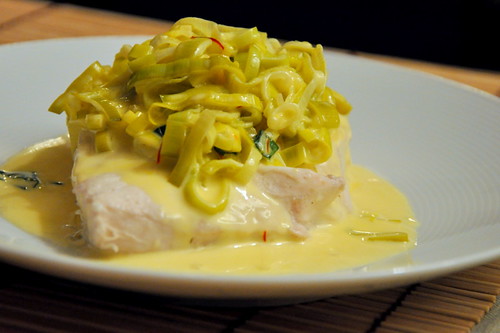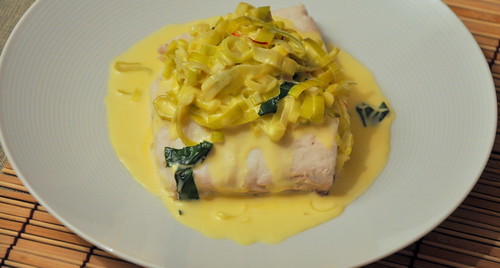Have you ever looked at a recipe and thought to yourself, “and on to the next?” There are thermometers involved, and complicated cutting procedures, long cooking times, kneading, etc. I’m all too familiar with that fear. Which is why, when Matt first gifted me with the Chanterelle cookbook (jam packed with recipes calling for truffles and unknown-t0-me spices), I was pretty sure that first Valentine’s Day recipe that he prepared for me would be the last from this book. And yet, I was wrong. We made it a mission to reserve a weeknight here and there to making one ridiculously over-the-top recipe just for the two of us. We’d hit the Ferry Building for some inspired ingredients, jam out and revel in our success.
What we’ve been missing all this time is a recipe for a dish that graces the book’s cover and is surprisingly easy to make. You wouldn’t know it by looking at that creamy yellow sauce. In fact, this recipe opened both of our eyes to a very unique way of preparing fish–a combination of poaching and steaming that creates the most divinely tender piece of fish. Cream, saffron and leeks seem like unlikely pairings for the delicate fish, but together they create an insanely delicate sauce that envelops the fish in just the right amount of flavor.
Beyond the saffron, all of the ingredients for this dish are pretty standard–we used the freshest piece of local halibut to make ours and opted for bottled clam juice instead of fish stock (the author suggests you can use either). While we chose to halve the fillets, we didn’t skimp on the sauce–and we didn’t regret making extra. Both of us wandered into the kitchen for spoonfuls of seconds and thirds. I could have eaten those leeks as a side dish.
Fear is a funny thing. Most of the time, we fear the things that are most unknown to us. The same is true for cooking. But cooking is, as everything else, all about getting over your fears. I remember first learning to dive–starting with rolling into the pool, then squatting and plopping in, then standing up and precariously falling with the straightest of intentions. And, then, finally, getting up on a diving board and springing forward. Flying never felt so terrifying. But breaking through the water is a feeling I’ll never forget.
Poached Halibut with Saffron-Leek Sauce
adapted from the Chanterelle cookbook
*serves 2
2 tablespoons of unsalted butter, at room temperature
1/2 shallot, minced
2 halibut fillets (we used local)
1/2 cup of dry white wine
1/2 cup of bottled clam juice
few pinches of saffron threads, more on hand to taste
1/2 teaspoon of fresh-squeezed lemon juice
pinch of kosher salt
2 large leeks, cut into thin ribbons (white and lightest green parts only)
1 1/2 cups of heavy cream
2 tablespoons of basil, cut into thin ribbons
1. Coat a 10 inch saute pan with 1 tablespoon of butter and sprinkle the minced shallot evenly over the pan.
2. Place the fillets of fish atop the shallots and pour in the wine and clam juice.
3. Cover the pan with a tight-fitting lid (or aluminum foil) and turn your burner to medium-high. Bring the poaching liquid to a rolling boil (about 3 minutes), then reduce the heat to medium and cook the fish for another minute.
4. Remove the lid and transfer the fish to a plate with a spatula. Cover the plate with foil to keep warm. The fish will be slightly undercooked, but will finish cooking as it transfers to the plate and steams slightly.
5. Pour out about 1/2 cup of the poaching into a bowl and toss the rest. Return the liquid to the pan and bring to a boil. Stir in the saffron, boiling for about a minute to allow it to flavor the liquid.
6. Add the lemon juice, 1 tablespoon of butter, salt, and leek ribbons, cooking for about 3-4 minutes.
7. Stir in the cream and allow the sauce to reduce a bit (and tenderize the leeks). Cook the sauce for about 5 minutes (it will turn a creamy, pale yellow). Add another pinch of saffron, if desired, as well as more lemon juice and/or salt. Once the sauce coats the back of a wooden spoon, stir in the basil and remove from the heat.
8. To serve, drain the fillets of any juices that accumulated on the plate and top with several hearty spoonfuls of sauce and leeks. Have extra sauce on hand–it is delicious.
Musical Pairings: Radiohead – In Rainbows + Halibut with Saffron-Leek Sauce






